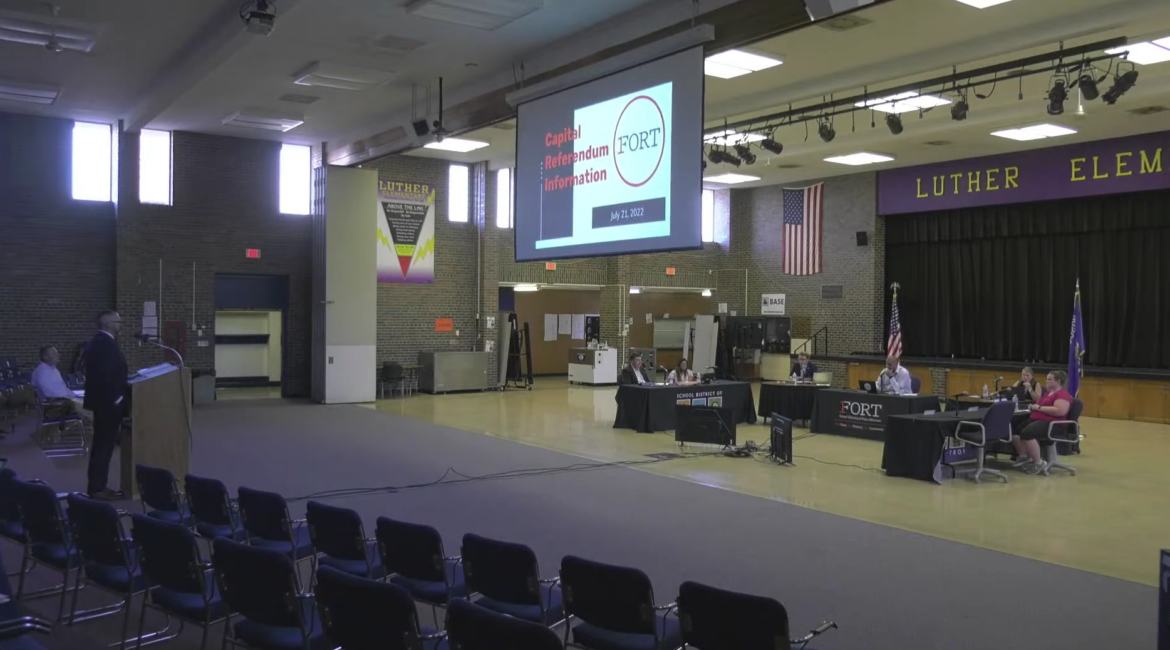By Kim McDarison
The School District of Fort Atkinson Board of Eduction Thursday received a presentation from Director of Business Services Jason Demerath about details regarding two proposed referendum questions for inclusion on the November ballot.
Information shared by Demerath in June indicated that the district would likely be seeking a $22 million referendum for capital improvements funding and an operational referendum as follows: a four-year recurring referendum of $2.7 million, a $4.4 million non-recurring referendum in the 2023-24 and 2024-25 school years, and a $5.5 million non-recurring referendum in the 2025-26 school year.
On Thursday, aided by slides, Demerath told those in attendance that improvements to the district’s facilities — as a result of an aggressive program in place to pay down capital debt — could be achieved through referendum dollars without increasing the district’s tax rate.
The board also received presentations from Nick Kent of Plunkett-Raysich Architects (PRA), and Dan Chovanec of CG Schmidt. Would a capital improvement referendum be approved by the voters, CG Schmidt would serve as the district’s construction manager.
Referendum questions to be placed before the voters in November, as proposed Thursday, would likely be brought before the board for approval next month, Demerath said.
Taking the podium on Thursday, Demerath began his presentation with reminding those in attendance of the district’s vision and mission, which, he said, “guide our work.”
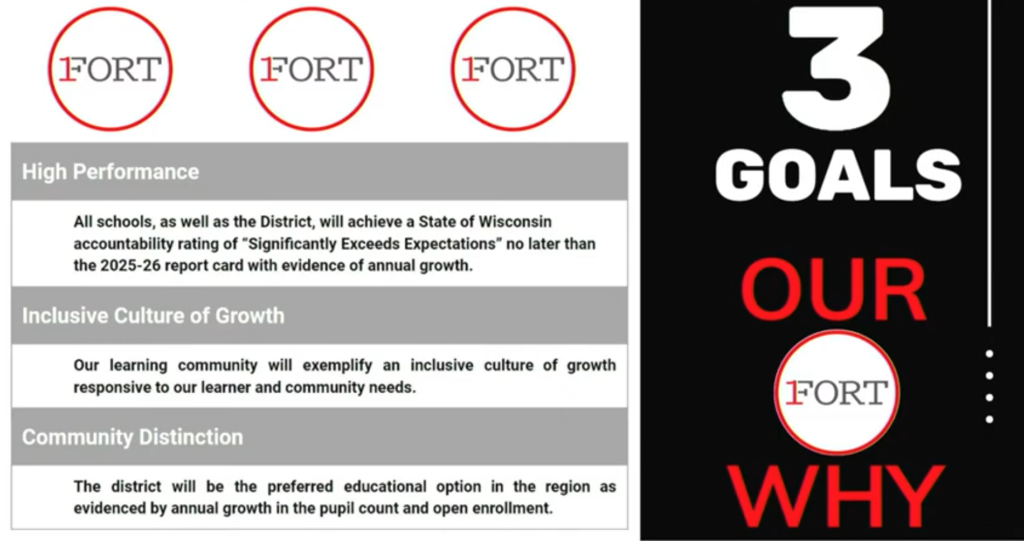
Demerath said within his presentation he would outline three goals, details regarding the goals, and the district’s strategic plan, which, he said, would tie the various components to the district’s beliefs and guiding principles, adding that the beliefs and principles “guide our day-to-day work and have been a part of our work throughout this referendum planning process.”

Citing beliefs, Demerath said that the district works to leverage its resources for student success, as well as the community’s investment in school facilities. In addition, he said, “We invest in our physical capital and showing pride and stewardship for our buildings, equipment and grounds.”
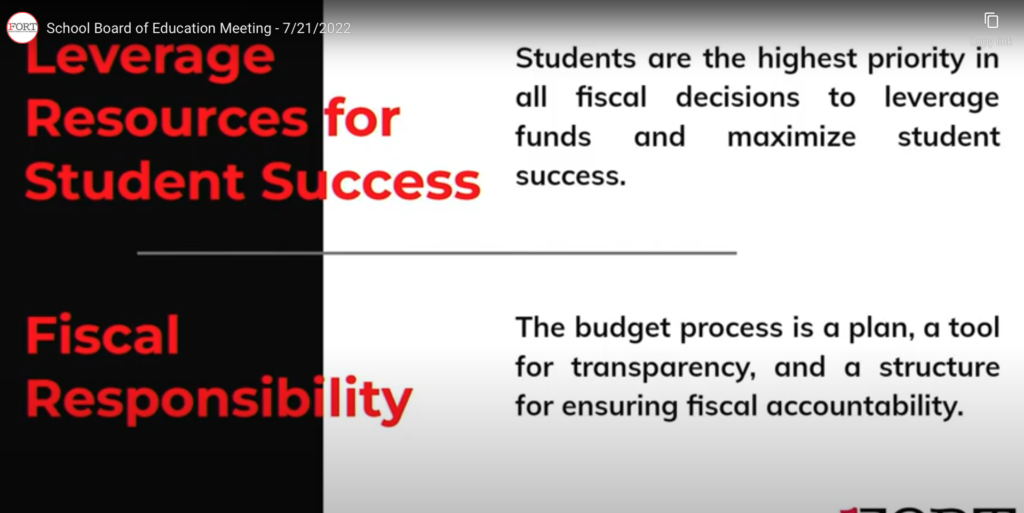
Citing guiding principles, he said, student success and students in general are the district’s “highest priority in all fiscal decisions.” He said the district’s focus on operational dollars ensures continuation of teaching and learning, which, he said, is “the core of what we do.”
He said he hoped the board and the public would see “the fiscal responsibility and transparency of what we are presenting as potential referendum questions and investments this evening.”
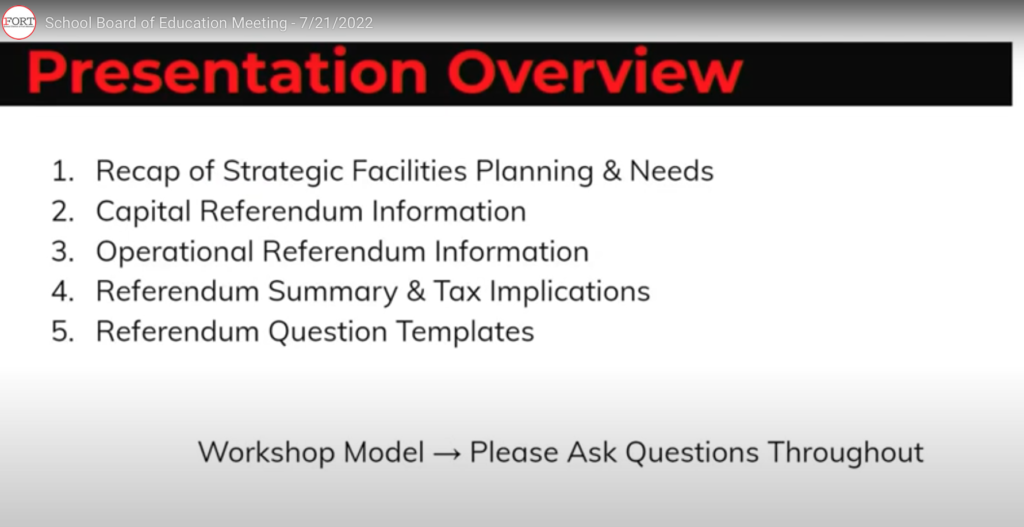
Looking to create a map to help guide information sharing, Demerath offered a recap of the district’s strategic facilities planning process and needs as shared during the board’s June meeting.
Representatives from the district’s consultants: PRA and CG Schmidt, would next present the capital referendum projects and information, he said.
Demerath said after the consultants made a presentation, he would return with information about the proposed operational referendums, tax impacts, and a first look at proposed referendum questions for inclusion on the Nov. 8 ballot.
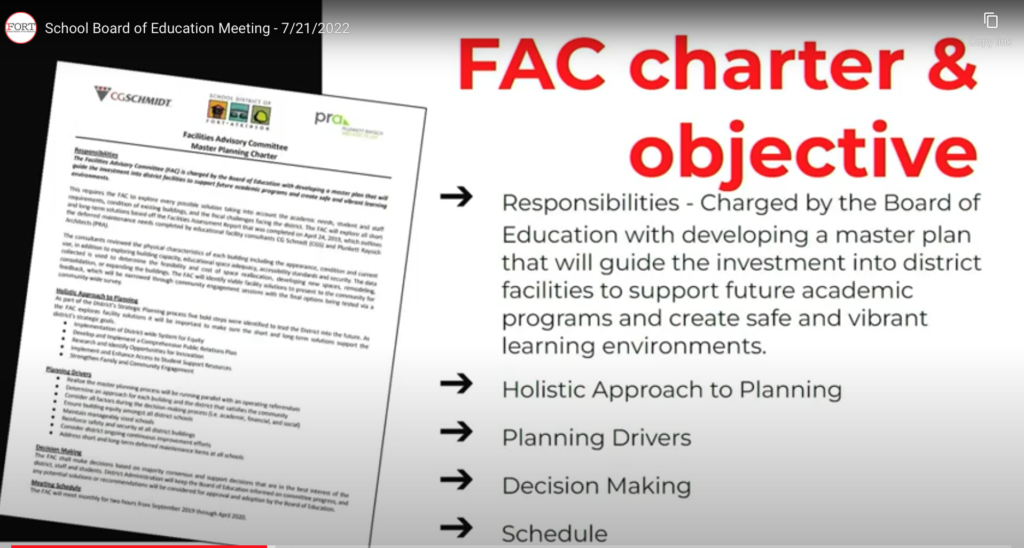
Demerath next shared a slide, shown above, which, he said, provided “a recap of where we have come over the past couple of years in our strategic facilities planning.”
He reminded those in attendance of the work done by the district’s facility advisory committee, comprised of community members and district staff, who were charged with developing a long-range master plan for investment in the district’s facilities.
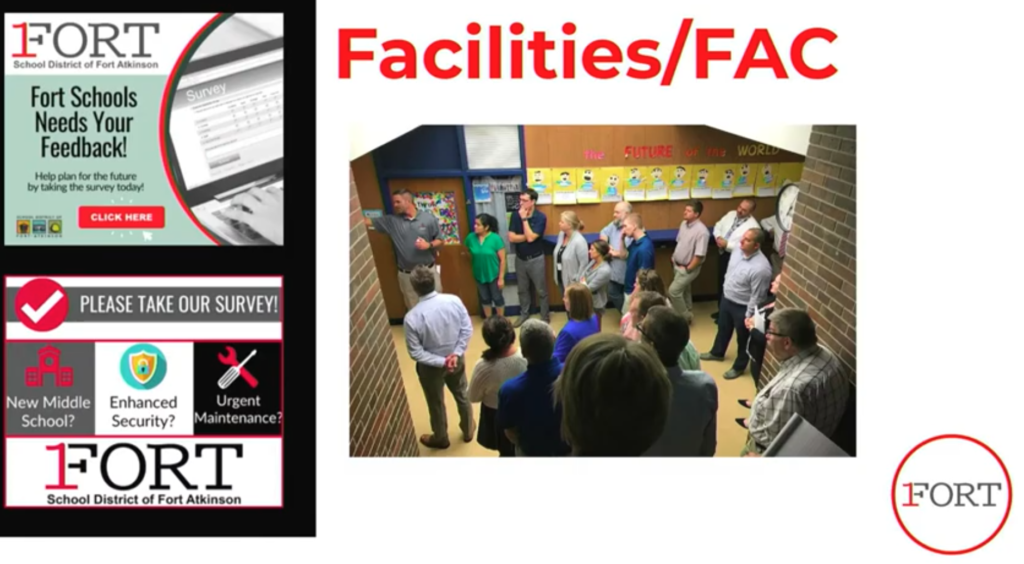
The group conducted tours of the district’s building and received detailed information of the state of each one, he said.

Following input from the advisory committee, Demerath said, a “phasing timeline” was developed. Thus far, he said, projects associated with Phase 1, including work at the high school, is nearing completion, and the district is moving onto beginning work slated for Phase 2.
As suggested by district administration last month, Demerath said, the district is looking into “further phasing” of Phase 2, which will see it taking place over the next few years.
“Phase 3 will then be somewhere down the road, maybe in about 10 years, to address what we want to do longterm with our four elementary schools,” he said.

Pointing again to information shared last month, Demerath said ongoing work at the high school would include a secure entry sequence, along with finalizing maintenance projects including some associated with Phase 1.
Additionally, the district would including proposals to address traffic flow at the high school, which, he said, “was a concern that was repeated from the community.”
Looking at elementary school needs, he said “we would look to do secure entry sequences and take care of urgent maintenance and mechanical needs to get those building through the next 10 years.”
No remodeling or modernizing of the building or learning spaces would be included in Phase 2, he said.
While the district had considered the prospects of building a new middle school, Demerath said, based on community feedback, the project “would be put on hold for a few years.” Instead, the district would look to include “a highly modified secure entry sequence” and perform maintenance needs which would allow the building to operate for the next five years.
Plans to build a new middle school would come before the board again, Demerath said, with a planning process for a capital improvements referendum potentially coming before voters in November of 2026.
Costs associated with work outlined by the district for capital improvements in Phase 2 would require a referendum of $22 million, he said.
Demerath next turned the discussion to the logistics surrounding proposed operational referendums.
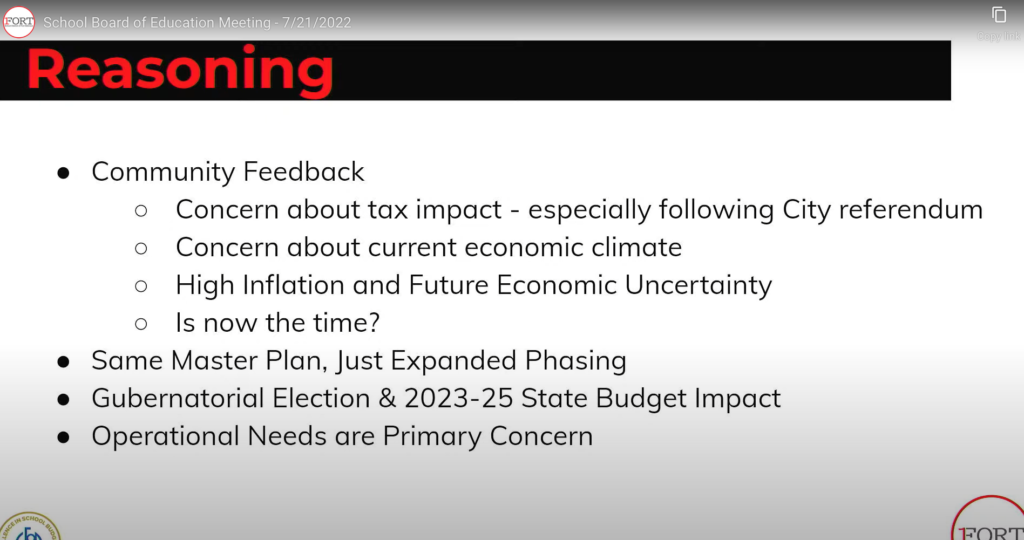
Demerath cited feedback from the community developed by the district through several mechanisms, including two community surveys. The information conveyed to the district that several factors, such as a referendum approved by voters in April to fund plans made by the city to bring EMS services in house and increase fire and EMS personal, along with changes in the economic climate and inflation, indicated that support for building a middle school this year had waned.
“I want to stress that we are continuing to work through the same longterm strategic master facilities plan, we are just taking our time based on the current environment that surrounds our organization,” Demerath said.
Looking at variables in the budget, Demerath said that changes in the way the state viewed operational funding, was creating a “fiscal cliff that we need to prudently address with longterm vision.”
He cited a shift over the last two years in state budgeting practices to operational funding with “no new state revenue,” coupled with the end of federal COVID relief funding.

The referendums, as proposed for inclusion on the Nov. 8 ballot, were devised to help lesson impacts from the aforementioned state budget changes, Demerath said.
“We have been aggressively paying down our capital debt to get to a point where we could do some capital project work through a referendum this year,” he said.
He continued: “What we are proposing this evening and everything you will hear can be done without an increase to the tax rate.”

Demerath next focused on the details of the operational referendum.
He noted that he had been working with the district’s financial advising company, Baird, regarding the district’s debt structure and “wrapping the capital debt around an operational referendum.”
Said Demerath: “We are proposing that the current non-recurring amount of $3 million dollars that expires at the end of this year be shifted to recurring this year, just as we have done with our prior two non-recurring referenda that expired where we then came back for voter approval to make those amounts recurring.
“With no new revenue projected at this point, given the uncertainty at the state level, we would then ask for $4 million dollars non-recurring in (school years) 23-24 and 24-25 and $5 million non-recurring in 25-26. All of these non-recurring amounts would be one-time amounts just in those particular fiscal years, they do not carryover from year to year.”
He continued: “I will also transparently share upfront that what is actually levied for operations in 2023 through 2026 will depend on financial changes that take place between now and then. Since the final year is four years from now, we will see a couple of state budgets between now and then that would impact us. So, the board in those years will have to take external factors like that into account each year as they set the levy. What we would be asking for here in the referendum is permission that these are the maximum amounts that would be levied.”

Pointing to a slide, shows above, Demerath said: “With no new revenue from the state being forecasted, you can see in red the significant operational deficits we face even with the attritions we made this year and only factoring in salary and wage increases of 3% each year, even though inflation is pushing 9% right now.”

Citing the next slide, shows above, he said: “what we see here is the three years of our current referendum followed by the three years of the proposed referendum. If we look at the cumulative deficit over the course of these combined six years, it would be $1.6 million dollars even with the proposed referendum given no new revenue from the state. In thinking longer term … we would have four years to address this $1.6 million through additional attritions, strategic abandonments, and/or new state revenue through the next two biennial budgets. During these upcoming years we will also be considering whether or not to continue the positions being funded by the ESSER federal COVID relief funds as those funds expire. We believe managing this cumulative deficit over this time is achievable without a significant impact to programming and will carefully consider how to manage it each fiscal year through our annual budget development process.”

Said Demerath: “To summarize, the total referendum package being proposed for November 8th, on the capital side we would install secure entries and address urgent maintenance needs at all six of our buildings, as well as improve traffic flow at the high school site as the new neighborhood comes online over there for a total cost of $22 million dollars financed through 20-year bonds.”

All improvements proposed Thursday, he said, would come at no increase to the district’s tax rate.
“To illustrate the tax rate impact of everything you heard this evening we have the tax rate history you saw earlier along with the projection (shown above) for the next five years added here incorporating this referendum and a preliminary look at the tax rate in 2026-27 with the new middle school,” Demerath said.

Demerath said it was the district’s goal to keep the district’s tax rate charged to taxpayers stable over the next four years. Offering transparency, he said that tax rates for homeowners could fluctuate if the value of their home increases or if funds paid out through the private school voucher program increase.

The slide above shows the operational referendum question proposed for placement on the Nov. 8 ballot. The resolution, to which taxpayers will be asked to respond “yes” or “no,” reads:
“Be it resolved by the School Board of the School District of Fort Atkinson, Jefferson and Rock Counties, Wisconsin, that the final school district budget beginning with the 2022-23 school year shall include an amount not to exceed $3,000,000 each year (on a recurring basis) and the following not to exceed amounts (on a non-recurring basis for a period of three years): $4,000,000 in the 2023-24 school year, $4,000,000 in the 2024-25 school year and $5,000,000 in the 2025-26 school year all in excess of the revenue limits imposed by Section 121.91 of the Wisconsin Statutes for the purpose of paying District operating costs in support of cultivating an inclusive high-performing culture of growth and community.”
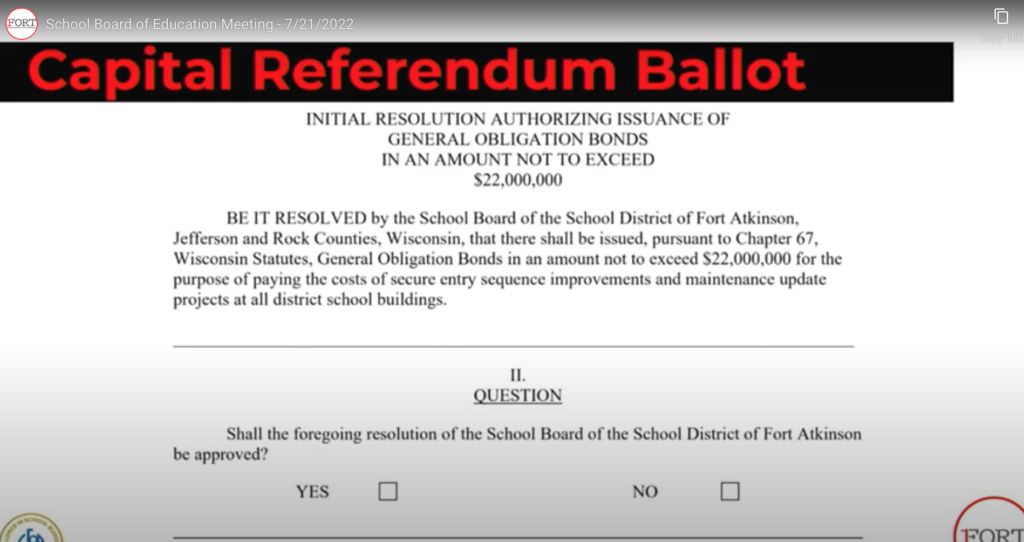
The slide above shows the capital referendum question proposed for placement on the Nov. 8 ballot, which reads:
“Be it resolved by the School Board of the School District of Fort Atkinson Jefferson and Rock Counties, Wisconsin, that there shall be issued, pursuant to Chapter 67, Wisconsin State Statutes, General Obligation Bonds in an amount not to exceed $22,000,000 for the purpose of paying the costs of sec cure entry sequence improvements and maintenance update projects at all district school buildings.”
Voters will be asked: “Shall the foregoing resolution of the School Board of the School District of Fort Atkinson be approved?” yes or no.
During his presentation, Demerath address several questions, including what would happen if either referendum would not be approved by the voters. His questions and responses follow:
Q: Why are we going to referendum this fall with both operational and capital questions?
A: As I had illustrated earlier we have a one-time window of opportunity where our current debt gets retired and we see an influx of state aid without a corresponding revenue limit increase. This results in the ability to do everything we talked about this evening with minimal impact to the tax rate.
Q: What if one of the questions passes and one fails?
A: If there is a question that fails we will be back in April of 2023 with another referendum question related to whichever one fails as the operational and capital needs are not going away. Should the capital question pass and the operational question fail, we will keep the tax rate at the current level and begin paying off as much of that capital debt as possible to set us up for another operational question in April.
Q: Will taxes decrease if both questions fail?
A Yes, taxes will decrease for the current 2022-23 fiscal year, but we will levy to pay off all of our debt this year and we will be back in April with both questions as the needs are not going away. This would then result in a tax increase the following year.
Q: Will the numbers change when we come back again in April for either or both questions?
A: Yes, the numbers will increase. By delaying operational funding we will need more funding to get through 2025-26 and by delaying the capital work, prices will continue to increase. Right now with inflation at 9% and some construction costs increasing more than that, pushing things by one year may mean an 8%-12% increase in costs for the maintenance work and secure entries.
An earlier story about the proposed referendums is here: https://fortatkinsononline.com/school-district-introduces-plan-for-22-million-capital-improvement-referendum/.
Survey results as shared by the district last month are here: https://fortatkinsononline.com/school-district-survey-shows-community-support-for-funding-elementary-school-maintenance/.
This post has already been read 2108 times!
